Michael Hedges’ Stage Rig
© 1996 Naked Eye Press
This page ain’t much to look at, but
it’s definitely all here. I was going to do it graphically in order to make it look a
bit slicker, but then I figured there’s really no point. This is as clear as it can
be. I’ve added notes, indicated by superscripted numbers, as well as links to
manufacturers pages if available. As far as I can tell, this page has more info on
Michael’s rig than anyone’s ever put together, so please read all the notes if
you’re confused about something. For the insatiable, I’ll grab his EQ and
processor settings during the fall tour and post them here as well. Also see
Michael’s sound system requirements for
the full picture.
Vocal/Flute
Acoustic Guitar
Low Strung Acoustic Guitar
Harp Guitar
Notes
Strings
Vocal/Flute Signal Path
Shure SM-15 Headset Condenser Mic 1
|
Samson UT-4 Transmitter mounted on derby or copper helmet
|
Samson UR-4 Receiver
|
T. C. Electronics 1140 Parametric Equalizer/Preamp
2
|
XLR out to Split Channel 1
Acoustic Guitar Signal Path 3
Low-Strung Acoustic Guitar Signal Path 6
L. R. Baggs Ribbon Transducer
+
Sunrise S-1 Magnetic Pickup
||
L. R. Baggs custom preamp/mixer on strap
|
Samson UT-4 Transmitter on strap
|
Samson UR-4 Receiver
|
T. C. Electronics 1140 Parametric Equalizer/Preamp
2
|
T. C. Electronics 1210 Spatial Expander 5
(in channel 2, out in stereo)
| |
L R
| |
XLR out to Split Channels 5 & 6
Harp Guitar Signal Path 8
Notes
- In 1994, Michael switched from regular
flute to alto flute, as seen below in ’95 (photo courtesy Ike Gauley). The Shure
SM-15 Headset Condenser Mic has been discontinued. See Shure
for current comparable models.

- Michael uses a total of four T. C.
Electronics 1140s—one for vocal/flute, one for his acoustic guitar’s FRAP
pickup, one for his acoustic guitar’s Sunrise pickup, and one for his low-strung
acoustic guitar. The combination of parametric EQ with the ability to get a 1/10th octave
Q setting plus the built in preamp make the 1140s ideal for Michael. He recently tried
other parametrics which can get even narrower Q settings, but according to his
guitar/stage tech, Jill Anania, the lack of an integrated preamp in the models he tried
threw his gain structure off and Michael didn’t like the interfaces as much.
- This signal path refers to Michael’s
ever-present 1971 Martin D-28, nicknamed
“Barbara” (since she’s spent so much time in bars), with which he has
always toured. Due to the combination of the Sunrise S-1 magnetic pickup and FRAP contact
pickup under the treble strings (and Michael’ phenomenal ability to EQ), Barbara has
a very distinctive, slightly throaty and brilliant tone. The basic idea is that the FRAP
handles all the transients and woodiness while the Sunrise gives fatness and low end (he
scoops the Sunrise EQ and particularly boosts around 64Hz). Barbara can be heard on most
tracks from Aerial Boundaries, Watching My Life Go By (also pictured on
cover), all of Live on the Double Planet, “Ritual Dance”,
“Dirge”, “Jitterboogie”, and much more.
 Michael and Barbara in ’94.
Michael and Barbara in ’94.
- FRAP stands for “Flat Response
Acoustic Pickup” and was created by Arnie Lazarus. Similar pickups are also made by Trance Audio under the name “Acoustic Lens”, although the FRAP in
Barbara and most of Michael’s guitars are Lazarus originals. Barbara’s FRAP is
mounted under the bridge on the treble side and provides Michael with the crystal clear
high end he is able to achieve live without a mic. Since the FRAP is a true 3-D transducer
and is extremely sensitive, it also picks up all of Michael’s thumps and slaps. To
get an idea of how sensitive it is, listen to the shaking sound 53 seconds into the live
version of “Silent Anticipations”. It’s Michael’s palm sliding over
the soundboard before his pick makes contact with the strings.
A voluntary plug by your webmaster here. I have two Trance Audio Acoustic Lenses in my
acoustic as part of the Amulet System.
When panned, they provide a beautiful stereo image and give all the brilliant highs and
complexity you hear in Michael’s sound (although I can’t comment on the music
itself or my ability to EQ it) as well as some huge lows. The Amulet rig is beyond
awesome. I’ve checked out a lot of other contact pickups and they don’t even
come close. They all sound like tin foil in comparison. And forget about saddle piezos
because they all make your strings sound like rubber bands in comparison. One last thing.
Personally, I recommend you do NOT install Acoustic Lenses yourself. They come with
installation guidelines to enable you to do it yourself, but from what Michael has told me
and what I experienced myself, the installation clearly involves a certain amount of
voodoo. I attempted the installation myself and ended up shipping my guitar cross country
to have Gary Hull at Trance redo it. You’ve got to nail the sweet spot with these
things and it’s easier and cheaper to let Gary do it. Since he reinstalled the
Lenses, my guitar sounds so good I haven’t used a mic since. And no, I’m not
getting paid to say all this. Just tryin’ to save you some hassle.
- The T. C. Electronics 1210 Spatial
Expander is the effect Michael is turning on and off from the stage and which provides his
“surround-sound”. He is only using this effect on the low end of the spectrum
via the Sunrise pickup. The high end via the FRAP is untouched. The combination results in
a more subtle and musical effect. Or as Michael says, “I want to make your heart
swim, not ‘swoosh’ your brain.” The 1210 has 2 inputs. With the front panel
switches in the proper positions, a signal introduced at the Ch. 1 input appears at the
1/4" Ch. 1 output as a stereo signal, with Right on the tip, Left on the ring, and
Ground on the sleeve of the 1/4" TRS jack. The same is true for Ch. 2. This allows
the 1210 to be used as two separate stereo chorus units, but cannot be done using the XLR
outs, as there are only two, and you’d need four to have L/R x2.
It is important to note that both the
T. C. Electronics 1210 Spatial Expander and T. C. Electronics SCF pedal have three
processing modes, i.e., chorus, flange, and pitch modulation. Michael does not use
these units in chorus mode, but rather in pitch modulation (PM) mode. PM mode provides a
significantly wider image yet is more subtle and “fluid”. Having purchased an
SCF pedal in late ’96 myself, I noticed a subtle design flaw which T. C. Electronics
has verified. In PM mode (but not in Chorus or Flange mode), newer SCFs produce an easily
detected “pop” during switching. Consequently, using it as Michael does by
frequently engaging and disengaging the effect during a tune proves distracting. Older
model SCFs, while having slightly noisier processors, do not produce a pop during
switching. Older model SCFs can be identified by a reddish/purple logo while newer models
have a bluish/purple logo.
- The first low-strung guitar Michael toured
with was a custom Takamine (below left, photo by Jay Blakesberg) which they presented to
him as a gift with his name on the headstock while on tour in Japan in the late 80s. His
favorite, however, is a Lowden L-250 (below center), although he has occasionally toured
with a Martin J-65M (below right).
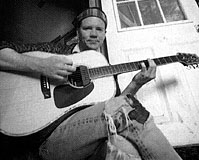
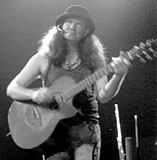
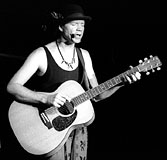
- Michael goes through phases with his harp
guitars. His first was a 1920’s Dyer configured with a FRAP/autoharp pickup combo
(below left). Next, he went to a Steve Klein electric harp guitar with a TransTrem bridge
(heard on “Point A” and “Point B”). Then to a black Dyer with a
FRAP/autoharp pickup combo—and rattlesnake tail wedged under the sub-basses at
headstock (essential for good earth tone!) (photo courtesy Alan Tignanelli). And finally,
back to his first Dyer, but reconfigured with a Sunrise S-1 and two Barcus Berry magnetic
pickups for the sub-basses which he glued straight to the body (photo courtesy Laurel
Paulson-Pierce).
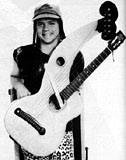


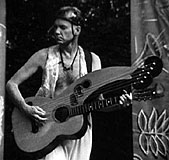
Strings
Michael uses D’Addario
strings. NW = nickel wound, PL = plain, and S = Steinberger (double ball-ended). Michael
does not use traditional bronze-wound acoustic guitar strings since they provide
less signal output to his Sunrise magnetic pickup.
Martin D-28:
E - NW056 (1.42mm)
A - NW046 (1.17mm)
D - NW034 (0.86mm)
G - NW026 (0.66mm)
B - PL017 (0.43mm)
E - PL013 (0.33mm)
Lowden/Martin low-strung guitar:
E - NW064 (1.63mm)
A - NW049 (1.24mm)
D - NW038 (0.97mm)
G - NW030 (0.76mm)
B - NW020 (0.51mm)
E - PL015 (0.38mm)
Klein electric harp-guitar (substitute NW’s
for S’s for acoustic harp-guitars):
E - SNW046 (1.17mm)
A - SNW036 (0.91mm)
D - SNW026 (0.66mm)
G - SPL017 (0.43mm)
B - SPL013 (0.33mm)
E - SPL010 (0.25mm)
All five harp strings are NW064 (1.63mm)
If you have other questions about Michael’s rig,
please send them to webmaster@nomadland.com.

Copyright
Notice


 Michael and Barbara in ’94.
Michael and Barbara in ’94.

